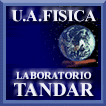|
Traditionally it has been assumed that orbital moments (OM) are quenched and that their influence
could be safely neglected when investigating the properties of 3d materials. Lately it has been
recognized that OMs can play a crucial role in the magnetic properties of 3d metals, and their
relevance to understanding magnectic anisotropy, important for technological applications, has been
demonstrated by a variety of experiments and calculations.
Fe impurities in Ag and Au, with similar spin moments, have hyperfine fields which differ by about
17 Tesla. The difference comes in large part from orbital contributions (1), which are significant
for Fe in Au, but close to zero for Fe in Au. Since the d-bands of Ag are much deeper than those of
Au, the higher OM of Fe in Ag is often attributed to the smaller hybridization with the d-bands of
the host, leading to a greater tendency towards an 'atomic like' behavior.
We use the RS-LMTO-ASA formalism to investigate the OMs of 3d impurities in Cu, Ag, Au as well as
in Cu(001) surfaces. While large 'atomic-like' OMs can be present in adatoms, the OM of 3d
impurities in Ag and Au are not governed by the position of the d-band of the host. For both Ag and
Au the OMs are negative for early 3d impurities and positive for Co. The values cross from negative
to positive in between: close to Mn in Ag and close to Fe in Au. As a consequence the OM of Fe in
Au is small, but for Fe in Ag it is already positive and significant in magnitude.
(1) R. Kirsch et al., Europhysics Letters 59 (2002), 430.
|
